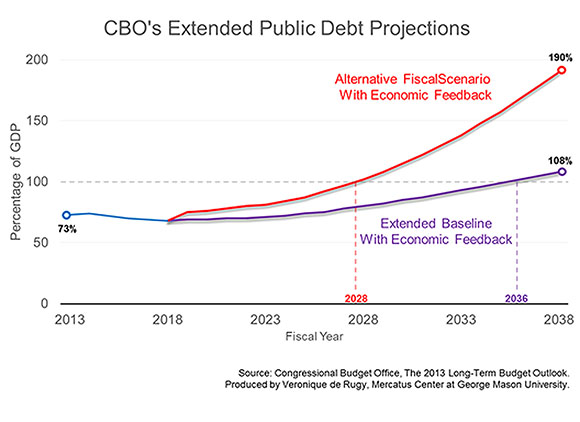- | Government Spending Government Spending
- | Expert Commentary Expert Commentary
- |
Sooner or Later, Politicians Must Get Serious About Controlling Spending
Congressional Budget Office officials released updated projections of the U.S.’s long-term budget outlook this week. Their report reveals nothing new; in spite of a real improvement of our fiscal outlook for the next few years, we are still drawing a blank to the realities of an unsustainable long-term fiscal path.
Congressional Budget Office officials released updated projections of the U.S.’s long-term budget outlook this week. Their report reveals nothing new; in spite of a real improvement of our fiscal outlook for the next few years, we are still drawing a blank to the realities of an unsustainable long-term fiscal path.
According to the CBO, the budget deficit is expected to fall from $1.1 trillion last year to $642 billion this year, a drop mostly due to unexpected tax revenue and some reductions in government spending. CBO projects that deficits will continue to decline through 2015.
Our future looks grim, however. Under the current law, the federal debt will grow from 73 percent of GDP today to 100 percent in 2038. This is a very rosy scenario based on the assumption that current law generally continues as scheduled – which means sequestration is continued, some temporary tax provisions expire, medicare physician payments are reduced and other provisions.
CBO's baseline scenario rests on optimistic economic growth and budget assumptions, and ignores among other things the long-run economic impacts like the crowding out of private investment from high debt.
So looking at CBO's extended baseline projections beyond 10 years gives a more realistic picture of our fiscal outlook since it accounts for harmful effects of debt on the economy, as well as lower levels of savings and revenue than projected otherwise.
Accounting for these economic changes, or what the CBO calls "economic feedback", the federal debt held by the public would reach about 190 percent of GDP by 2038.
As always, the main culprit of our growing debt is the explosion of Medicare and Social Security spending. As the Committee for a Responsible Federal Budget explains in a recent analysis of CBO's new report:
"Beyond rising interest costs, the projected increase in spending is driven largely by the growth of federal health programs – including Medicare, Medicaid, and ACA insurance exchange subsidies – as well as the rising cost of Social Security benefits."
CBO estimates that federal spending for the major health care programs and Social Security would increase to a total of 14 percent of GDP by 2038, twice the 7 percent average of the past 40 years.
They also find that by 2038, federal spending would increase to 26 percent of GDP under the assumptions of the extended baseline, compared with 22 percent in 2012 and an average of 20.5 percent over the past 40 years.
Interestingly, overspending will continue despite larger tax collection than in the past; tax revenue as a share of GDP will increase to 19.5 percent of GDP by 2038, compared with an average of 17.5 percent over the past four decades.
CBO adds, “The structure of the federal tax code means that revenues would also represent a larger percentage of GDP in the future than they have, on average, in the past few decades—but not large enough to keep federal debt held by the public from growing faster than the economy starting in the next several years.”
Considering the fact that our current level of debt, at 73 percent, is already unusually high (compared to 36 percent in 2007), more overspending by the government will be extremely harmful to the economy.
Unfortunately, our situation is much worse than these numbers suggest, since they do not account for the trillions of dollars of unfunded liabilities accumulated over the years by the government.
According to the Financial Statement of the United States, which looks at the government’s net financial position, as of 2012, the American people have been promised about $55 trillion worth of future benefits (through Social Security, Medicare, and other government programs) that the federal government does not have the money to pay.
This $55 trillion estimate pales in comparison to estimates from other studies, like one from former Securities and Exchange Commission Chairman Christopher Cox and former House and Ways Committee Chairman Bill Archer, which found roughly $87 trillion in unfunded liabilities using Medicare and Social Security trustees' reports.
Also, Boston University economist Laurence Kotlikoff calculates a “fiscal gap” amount of $222 trillion using the CBO’s alternative long-term budget forecast.
Kotlikoff's fiscal gap measure takes into consideration the present value of all expenditures from now through the end of time (including servicing the official debt) and subtracts all the projected taxes from that amount.
Yet some in Congress are talking about repealing the tiny short-term sequester cuts, while very few lawmakers are serious about the long-term challenges such as reforming entitlement spending.
As CRFB President Maya MacGuineas explains, "Jumping from crisis to crisis with one short-term solution after another is not going to change the skyrocketing trajectory of our debt.
"Instead of focusing on the next election, policymakers should focus on the next decade and the next generation."
As they enter into one more set of CR and debt-ceiling talks this fall, lawmakers need to remember these numbers. It is time to start being serious and cut spending.
